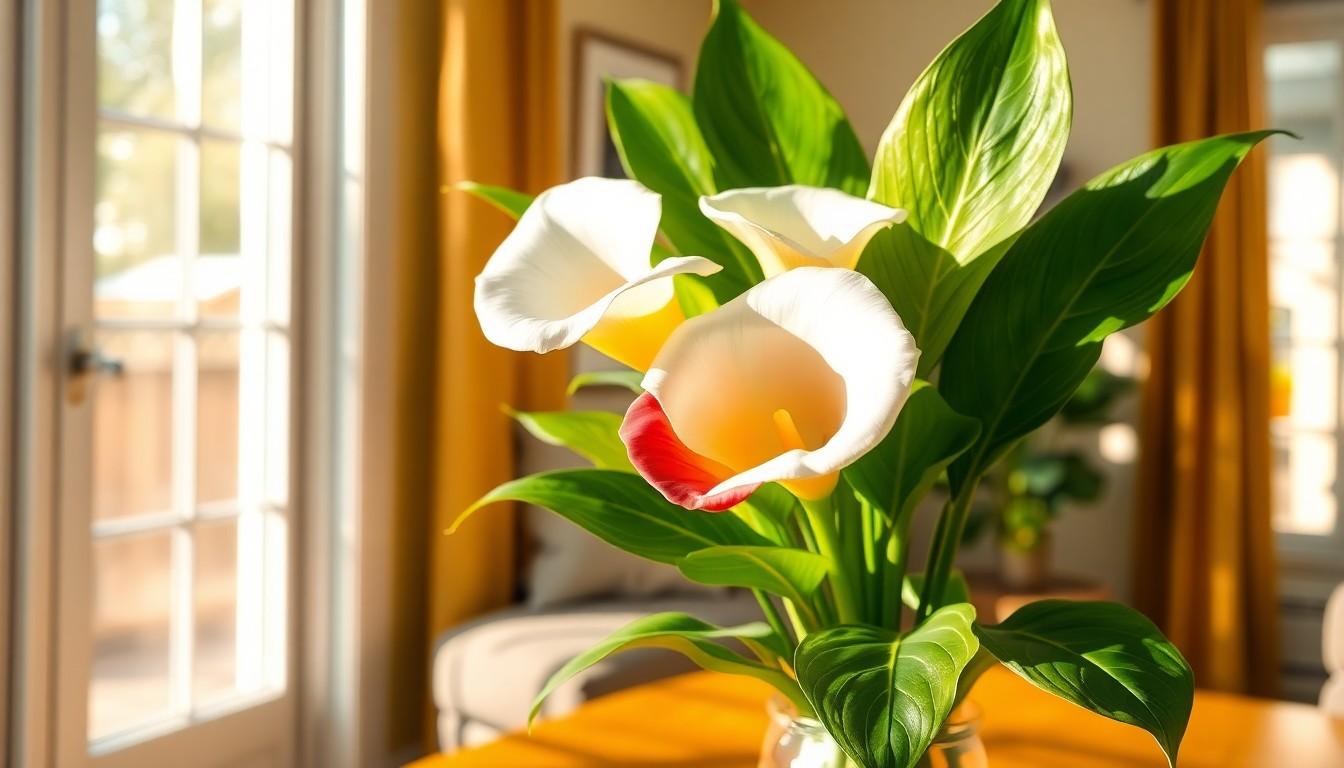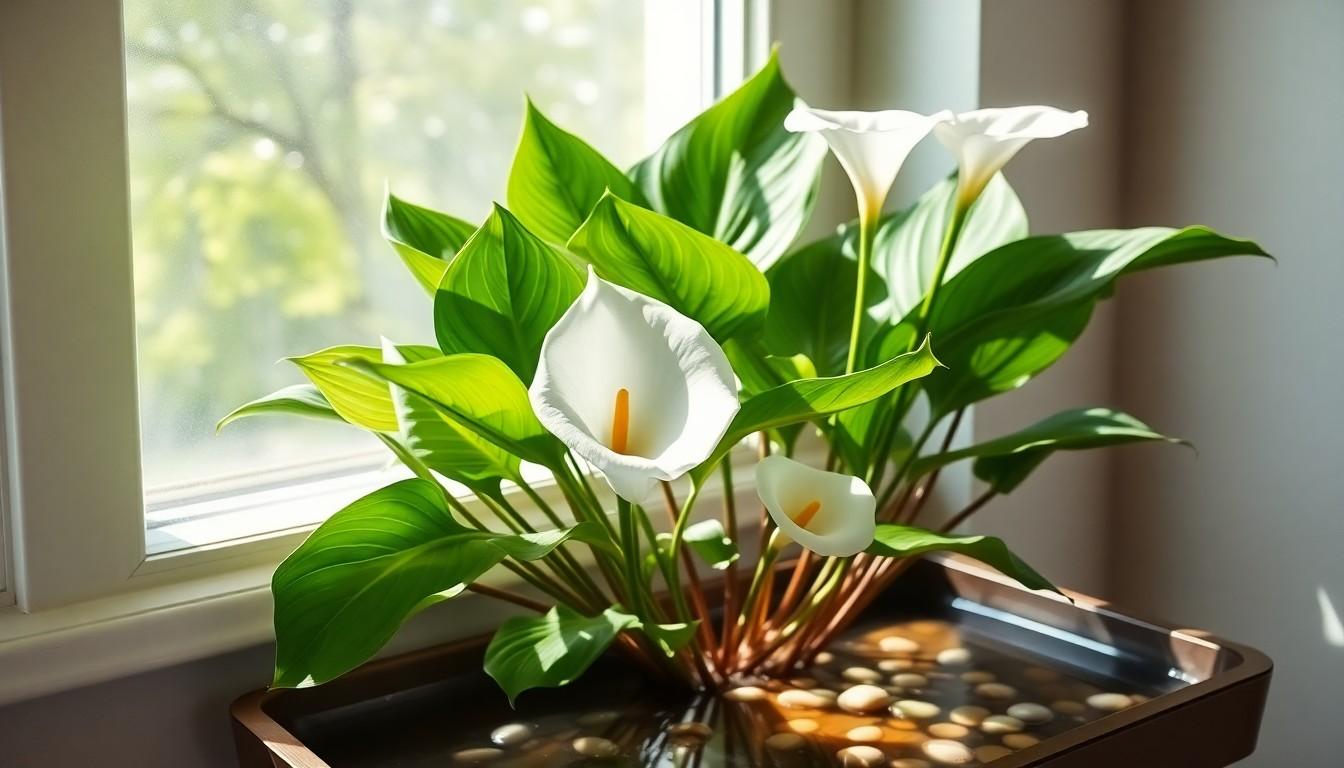Physical Address
304 North Cardinal St.
Dorchester Center, MA 02124

If you’re looking to add a touch of elegance to your indoor jungle, the calla lily is your go-to plant. With its sleek, trumpet-shaped blooms and glossy leaves, it’s like the fashionista of the plant world, always ready to impress. But don’t let its glamorous looks fool you; this beauty has some care requirements that need attention.
Fear not, aspiring plant parent! Caring for a calla lily indoors can be as easy as pie—if pie were a delicate balance of light, water, and a sprinkle of love. Dive into this guide and discover how to keep your calla lily thriving, turning your home into a botanical runway. After all, who wouldn’t want a plant that’s as stylish as it is stunning?
Calla lilies stand out as elegant indoor plants, showcasing stunning trumpet-shaped blooms and glossy green leaves. Originally native to southern Africa, these plants thrive indoors when given proper care. Known for their beauty, calla lilies offer a variety of colors including white, yellow, and pink.
Light plays a crucial role in the growth of a calla lily. Bright, indirect sunlight promotes flowering and healthy foliage. Placing the plant near east or west-facing windows provides the ideal light conditions. Conversely, too much direct sunlight can scorch the leaves.
Watering practices significantly impact plant health. Calla lilies prefer consistently moist soil, but they require good drainage to prevent root rot. Checking the top inch of the soil ensures the plant doesn’t dry out, and adjusting the watering schedule during the growing season can enhance blooming.
Humidity levels are also important for these plants. Calla lilies enjoy humidity, thriving in environments around 40 to 60 percent. Increasing humidity can be achieved through methods like misting during dry months or placing a pebble tray under the pot.
Fertilization supports robust growth and blooming. Applying a balanced liquid fertilizer monthly during the growing season can stimulate flower production. Reducing fertilizer in the fall allows the plant to enter a dormant phase, conserving energy for the next growth cycle.
Pest management should be a priority for indoor calla lilies. Common pests include aphids, mealybugs, and spider mites. Regularly inspecting the leaves and treating any infestations promptly keeps plants healthy.
Calla lilies require specific care to flourish indoors. By focusing on light, watering, humidity, fertilization, and pest management, plant owners can enjoy their vibrant beauty year-round.

Calla lilies thrive in specific conditions that support their growth and blooming. Providing the right environment ensures vibrant flowers and healthy foliage.
Bright, indirect sunlight fosters optimal growth for calla lilies. Positioning the plant near a window where it receives filtered light supports its development. Too much direct sunlight can scorch the leaves, whereas insufficient light leads to leggy growth and fewer blooms. Regularly rotating the plant helps it receive even sunlight exposure.
Maintaining temperatures between 65°F and 75°F creates a healthy habitat for calla lilies. During the night, temperatures can drop to around 60°F, promoting rest without stress. High humidity levels between 40 to 60 percent enhance the plant’s environment. Utilizing a humidity tray or regular misting can increase moisture, vital for leaf health and flower production.
Calla lilies require careful attention to watering and feeding for optimal growth. Ensuring the soil remains consistently moist promotes healthy blooming.
Watering should occur when the top inch of soil feels dry. Overwatering can lead to root rot, so good drainage is essential. During the growing season, typically spring and summer, water more frequently. Reduce watering in fall and winter, allowing the plant to rest. Use room temperature water to avoid shocking the roots. Monitoring for signs of drooping leaves signals a need for moisture.
Fertilizing calla lilies supports growth and flowering. A balanced liquid fertilizer, such as a 20-20-20 formula, should be applied every four to six weeks during the growing season. Diluting the fertilizer to half strength prevents over-fertilization. Avoid fertilizing during dormancy in fall and winter. Adjust fertilizer application based on growth patterns and leaf health. Regular feeding ensures vibrant blooms and lush foliage.
Proper potting and soil choices significantly impact the health of the calla lily. Selecting the right container and soil composition ensures optimal growth and blooming.
Opt for a pot with drainage holes to prevent water accumulation. Terra cotta or ceramic pots are excellent options as they allow for airflow. Ensure the pot size is appropriate, ideally 2 inches larger than the previous pot, to support root expansion. Consider a shallow pot since calla lilies have a relatively shallow root system. A well-chosen pot enhances stability and promotes healthy root development.
Use a lightweight potting mix to retain moisture while ensuring good drainage. A combination of peat moss, pine bark, and perlite creates an ideal environment. The soil pH should range from 6.0 to 6.5 for optimal nutrient absorption. Frequent checking for compacted soil is essential since it can hinder root growth. Regularly amending the soil with organic matter can also boost its nutrient content.
Calla lilies can face various pests and problems that affect their health. Monitoring plants regularly helps in early identification of issues, ensuring better care.
Aphids are common pests that often cluster on leaves, sucking sap and causing yellowing. Spider mites also threaten health, leaving tiny webs on the foliage and leading to leaf discoloration. Mealybugs, resembling cotton-like masses, may appear at leaf joints, feeding on plant sap. Scale insects, visible as small bumps on stems, can weaken the plant over time. Identifying these pests early can prevent severe infestations and damage.
Maintaining high humidity levels effectively deters many pests, as dry conditions encourage infestations. Regularly inspecting foliage helps catch issues before they escalate. Keeping the plant clean by gently wiping leaves with a damp cloth removes dust and potential pests. Additionally, using insecticidal soap or neem oil sprays provides a natural remedy for infestations. Quarantine new plants for a few weeks to avoid introducing pests to existing plants.
Caring for a calla lily indoors can transform any space with its stunning blooms and lush foliage. By providing the right balance of light humidity and temperature these plants can thrive and bring joy for years. Regular monitoring for pests and maintaining proper watering and feeding schedules are essential for their health. With a little attention and care calla lilies can flourish and enhance the beauty of any home environment. Embrace the elegance of this remarkable plant and enjoy the vibrant touch it adds to your indoor garden.